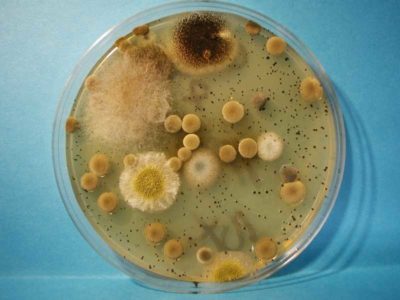Mold 101
Mold is everywhere! It is fungi found both indoors and outdoors. It can even survive space travel. No one knows how many species of molds exist, though estimates range from tens of thousands to perhaps 300,000 or more.

We consider outside levels of airborne molds to be typical, or levels that would be normal if found indoors. In seasonal areas of the world, outside mold levels will change as the seasons change. In tropical and areas, where humidity runs high, outside levels and types of mold can be quite different than in dry areas like Tahoe. Outside molds, like ones found indoors, can impact humans and animals. In most cases, it is indoor mold levels that most concerns us. When there is an indoor mold source, air levels can be found more than 100,000 times greater than the outside levels. This is referred to as “sick building syndrome”.
Molds spread and reproduce by making spores. These spores can float freely in the air until they land on a surface that can support growth. Molds require organic based materials like wood or paper for food. Molds grow best in warm, damp, and humid environments. They typically won’t propagate at temperatures below 50*F. However, mold spores can survive harsh conditions that do not support mold growth.
Human Exposure
- We are all exposed to mold in both outdoor and indoor air.
- Unless exposed to high levels, most people will not be affected by small amounts of mold exposure.
- For healthy people exposed to non-toxic molds, symptoms are typically no worse than those with a cold or allergies.
- People with serious allergies to molds may have more severe reactions, including fever and shortness of breath.
- People with chronic lung illnesses, such as obstructive lung disease, may develop mold infections in their lungs.
- People with immune compromised illness may have a higher risk of mold-related illness and fungal infections.
Center for Disease Control and Prevention
I think I have Black Mold!
- Many of the thousands of mold species appear black.
- Many of these black molds are common in our environment and pose no additional danger because of their color.
- Stachybotrys is a greenish–black, slimy mold found only on cellulose products. Commonly referred to as “black mold”.
- In 1994, the CDC investigated whether exposure to Stachybotrys might be related to pulmonary hemorrhage.
- Containing mycotoxins, this species of mold is thought to present health risks beyond what would be associated with common molds.
If you think you have a mold issue, it is best to have it evaluated by a professional. For additional information about our mold inspection services, please click on the below links.
If your project has already been evaluated by a qualified professional, we offer free estimates.
If you want additional information about mold, please click on the resources below to gain a better understanding of mold and the problems it can cause.
- PowerPoint About Mold
- Common Mold Sources
- https://www.epa.gov/mold/mold-cleanup-your-home
- https://www.cdc.gov/mold/default.htm
Resources for:
